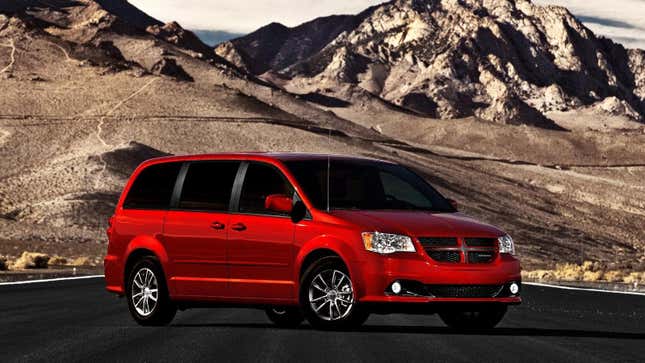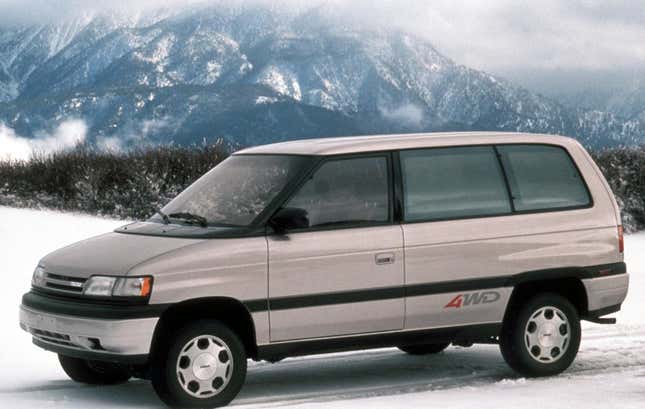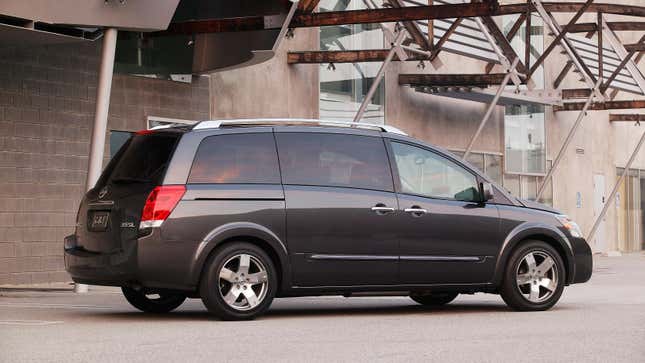
Vans, specifically minivans, used to be one of the dominant automotive segments in the United States. Now, the once-fruitful offerings have shrunk down to just four models from four manufacturers: Toyota’s Sienna, Kia’s Carnival, Honda’s Odyssey, and Chrysler’s Pacifica. But back in the day, there used to be some actually interesting options in the family hauler segment.
Nowadays, those offerings have shrunk thanks to the growth of the SUV and crossover segments — but here at Jalopnik, we’ll never forget some of the best minivan models of the past. In fact, today we’re going to celebrate them.

Dodge teased performance vans over the years resulting in two concepts a decade apart. The first Caravan R/T Concept was based on the third generation Caravan and was shown in 1999. It was powered by a V6 making 325 horsepower and looked the part with decals and spoilers. The second Caravan R/T concept was a mysterious one shown at the 2009 Detroit Auto Show. No info was given about it, but it had a hood scoop, dual exhausts and SRT-looking 20-inch wheels.
The production version of the Caravan R/T was much less exciting. Debuting for 2011, it was one of the first Chrysler models to get powered by the then new 3.6-liter “Pentastar” V6 with 283 hp. It also received a 12 mm lower ride height, rear spoiler, body color grille and 17-inch wheels.

More of a small MPV, the Eagle Summit was one of the models developed during the Chrysler/Mitsubishi partnership that was Diamond Star Motors. It was also badge-engineered as the Mitsubishi Colt and Plymouth Colt Vista.
The Summit was introduced in 1992 and could be had with all-wheel drive. It was presented to consumers as the best of both worlds: the maneuverability of a compact car with the high seating position, cargo flexibility and sliding side door of a minivan. It lasted until 1996, two years before the Eagle division itself was folded.

You’re probably wondering why the Windstar is on this list. It wasn’t rare, and it was sold for years. It’s on this list, though, because of a unique feature many probably forgot it had.
Ford was in panic mode when Chrysler released all new versions of its top selling Caravan/Town & Country/Voyager in 1996. Chrysler blindsided the market by offering a feature not seen before: dual sliding doors. This threw Ford off, as the company had just released the new Windstar a year prior with just a single sliding door. Unable to go back and and add a second sliding door, Ford made the driver-side door on the Windstar six inches longer for 1998. It was also designed to open wider while the driver’s seat gained the ability to tilt forward and slide. They called this the Family Entry System. A year later, an all-new Windstar debuted with dual sliding doors.

A badge job of the second generation Kia Sedona/Carnival minivan, the Entourage was Hyundai’s only attempt at a minivan in the U.S. Power came from a 3.8-liter V6. It was only sold for two model years before it was dropped in 2009. Some say that Hyundai didn’t want two seven-seat vehicles in its lineup selling against each other; the brand had introduced the Veracruz crossover just a few years prior.

In another one of the many instances of Isuzu going elsewhere for a vehicle to sell, from 1996-1998 the company sold a rebadged version of the first-generation Honda Odyssey. Isuzu called it the Oasis. Isuzu briefly continued to sell the Oasis after Honda introduced a second-generation Odyssey in 1999.

Another small van/MPV that was random for the U.S. market, the Kia Rondo was introduced for the 2006 model year. While new for us, it was actually the second generation of a vehicle sold elsewhere in the world since 1999 called the Carens.
The Rondo was unique in that it had a van-like body but four actual doors like a sedan. Power came from a base 2.4-liter I4 or an optional 2.7-liter V6 on upper trims. And it was cheap. Pricing started at just $16,995; loaded with features like the aforementioned V6, a third row (!), leather seats and a power sunroof, you would still only be looking at $23,495.

Mazda was all over the place with the MPV. Introduced for 1988, it was designed specifically to be a minvan for the U.S. market. However by the early to mid 1990s, Mazda was offering it with an uncomfortably high ride height and a selectable 4WD system with some body cladding thrown in. It was a weird sort of off-road van before it was redesigned in 1999.

By then it had morphed into a proper minivan to take on the likes of the Honda Odyssey, albeit with Mazda’s signature “zoom-zoom” tuning for a better driving experience. The MPV lasted until 2006, when it was replaced by the full size seven seat CX-9.

Another one of the random small MPV/van offerings in the U.S. during the mid to late 2000s is the Mazda5. The rest of the world got this vehicle in 1998, but it didn’t come to the U.S. until its second generation in 2005. Designed during the years Ford owned Mazda, engineers were able to squeeze three rows of two seats onto a platform that was shared with the Euro-market Ford Focus, Ford C-Max and Volvo S40. Impressive.

Mazda managed to get another generation out of the Mazda5 before the brand realized that its crossovers were more popular, and it was discontinued in the U.S. in 2015; it continued on in other markets until 2018.

A rebadge job of a Ford Freestar with chrome trim? It’s understandable if you don’t remember this thing. The only notable feature in the Monterey was its rather big 4.2-liter V6.

During the mid- to late-1980s, there was a Japanese van boom. Sort of. Japanese automakers all seemed to bring to the U.S the same genre of durable, rear-wheel drive, unique-looking vans. Nissan was one of them selling its Van, also known as the C22 or the Vanette, in the U.S. from 1986-1989.
It was troubled from the start. To meet American demands for highway driving and power, Nissan threw its 2.4-liter Z24 engine into the Van. With 106 hp and 137 lb-ft of torque, it wasn’t powerful, but it was normally used in truck applications. Seeing as the Van wasn’t designed to fit such a large engine, the Z24 filled the engine bay. This ended up causing serious issues like overheating and fires.

Another quirky MPV van, Nissan originally marketed this thing as the Stanza Wagon when it was first offered in the U.S. for 1982 (it was called the Prairie in the rest of the world). When the second generation debuted for 1988, Nissan changed its name to Axxess. It was unique in that it had dual sliding doors. U.S. versions got the largest engine offered anywhere in the world, a 2.4-liter, the same engine used in the 240SX at the time.

While the Quest isn’t as forgotten as some of the models here, the third generation is being mentioned here because of how unique it was. Nissan and Ford jointly developed the first and second generation Quest, which was also sold as the Mercury Villager. It was nothing special and blended in with the crowd. The third generation debuted for the 2004 model year and was almost avant garde in its design, which made for a unique and cool looking offering for the segment.

The most unique aspects of its design were in the interior, from its table-like front gauge cluster, optional orange leather seating, dual screen DVD setup for both second and third rows, and the most unique offering at the time, its Sky View roof. This equipped the Quest with four skylights, one above each seat in both the second and third rows, in addition to a front sunroof.

Yes, the Quest gets two mentions here. After a year hiatus, a fourth-generation Quest debuted in 2011. Its unique design continued with an exterior based on the Nissan Forum concept shown a couple of years prior. Its design was distinctly Japanese, almost looking like a large version of a Japanese Kei van. The Sky View roof carried over but it gave way to a fixed rear glass panel over the second row instead of the multi-panel setup the previous generation had.
While the Quest was dropped in 2016 due to slow sales, it has the distinction of having one of the worst IIHS crash test performances in history. In a 2014 test of various van models on the market, Dave Zuby, vice president for the IIHS, remarked that the Quest’s performance was one of the worst he had ever seen.
A person experiencing this would be lucky to ever walk normally again. The corner of the driver’s door was pushed in two feet during the crash. As a result, the floor and instrument panel pinned the dummy into its seat. We had to remove the seat to cut the dummy out of the vehicle.

During GM’s era of weird U-Body vans — vans that were designed to combine crossover looks with van versatility — every GM division received a badge-engineered version, except GMC and Hummer, of course. While other brands had offered minivans before, there were only two that had escaped the trend: Buick and Saturn. GM waited until 2006 to give the “different kind of car company” its first van in the Relay.
It really wasn’t anything special. Aside from the the Saturn badges and some trim, it was identical in every way to every other U-Body van sold at Chevy, Buick, and Pontiac. The Relay was discontinued in 2007 when it was replaced by the Outlook, a variant riding on GM’s Lambda platform.

Similar to the Nissan Van, the Toyota Van was another rear-wheel drive offering from Japan brought to the U.S. by Toyota in 1984. While this was the first time the Van had been brought to North America, it was actually the second in a series of vans called the LiteAce that had been on sale since 1970. The series the U.S. received was called the R-Series.
The Van was unique for many features, like its short wheelbase that caused passengers to sit over the front axle, its mid-engine, 2.0-liter 90-hp I4 that powered the rear wheels, and a cooler box. Lines carried A/C refrigerant into the box to keep it cold. The box even came with two spill proof ice trays!

How could we not mention the Previa? Debuting for 1990 in the U.S., it replaced the Van. Toyota thought it could compete with Chrysler’s offerings with unique styling and packaging. The Previa proved to be more popular than the Van, but it didn’t quite get the marketshare that Toyota was after. Its unique styling and equally unique mid-engine layout proved to be problematic.
While enthusiasts like us look back on its mid engine layout as something cool, both Toyota and its customers struggled with the format. The unique packaging requirements of the mid engine layout only allowed Toyota to offer a 2.4-liter, 133-hp engine, nothing bigger. Meanwhile U.S. buyers wanted more power, and Chrysler’s V6-powered vans were selling well. To remedy this, Toyota fit the 2.4-liter engine with a supercharger in 1994, resulting in 158 horsepower and increased fuel efficiency. Sadly, though, sales didn’t get better, and the Sienna replaced the Previa in 1997. The Previa soldiered on in the rest of the world in its bubble form until 2000 and continued on until 2019.

This list wouldn’t be complete without mentioning the Routan. The Routan was rolling proof of VW’s inability to understand the U.S. market. VW wanted more vehicles specifically for the U.S. market but didn’t seem to want to spend any money to develop them. Having never offered a minivan in North America, VW partnered with Daimler Chrysler to develop one. Execept they didn’t. Remember VW didn’t want to spend the development money. So the Diamler Chrysler partnership resulted in VW heavily rebadging the Chrysler RT platformed minivan.
While the Routan got unique front and rear fascias and a distinct gauge cluster, it was nearly identical to the Town & Country/Caravan of the time. Chrysler didn’t let VW use its Stow n’ Go system however. Engines were identical though, with the Routan using Chrysler 3.8-liter and 3.6-liter Pentastar V6 engines.
VW was over ambitious in its sales projections for the Routan; the brand predicted it would take five percent of the U.S. van market when it debuted in September 2008. By January 2009, VW told Chrysler to hold production of the Routan the following month because dealers had received 29,000 they couldn’t sell. By the summer, just under 12,000 had been sold. By 2014, its final year on the market, only 1,103 had been sold the whole year.